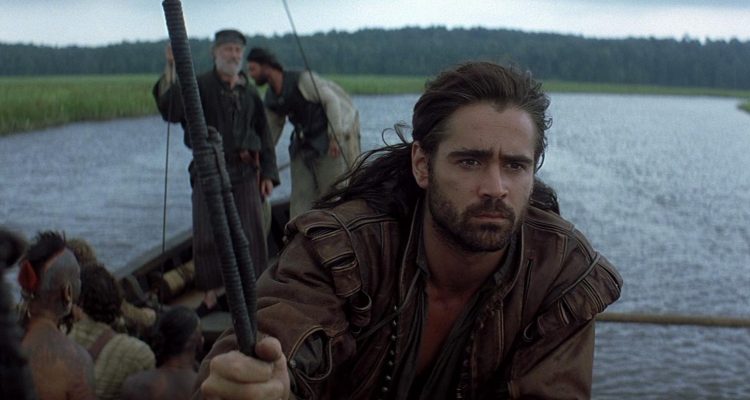
First Sight — “The New World” (2005), DP: Emmanuel Lubezki
Almost every Malick film contains within it the seeds of the next. But perhaps one of the reasons I admire more than love “The New World” (aside from not being able to get past Colin Farrell‘s artisanal hunkiness as John Smith), is that as a total devotee of “The Thin Red Line,” a lot of the most striking images and moments here remind me of ones Malick had done before, albeit with a different DP. This shot is kind of a case in point — it mimics Jim Caviezel spotting the warships’ arrival from his own native paradise in the beginning of ‘Thin Red Line’ — but the different import gives this iteration undeniable gravitas. It’s also exciting that it is from point of view of Pocahontas (Q’orianka Kilcher) — Malick can often be guilty of reducing his women to ciphers, but oddly enough in a young 17th-century Native American woman, he created his most appealing and relatable (albeit tragic) heroine.

Staircase and Doorways — “To The Wonder” (2012), DP: Emmanuel Lubezki
If Malick is rightly lauded for his facility with beauty shots and nature scenes, he’s less frequently cited as a great choreographer. And that doesn’t seem quite fair: One of the positives associated with the negative observation that he often uses his actors more like props is that he takes great care in positioning them in relation to each other and the camera, and having them move in precisely controlled ways. One of the simplest and most dramatic demonstrations of that is in this shot (done no favors in still form, really), in which the synced-up disconnectedness between Ben Affleck‘s Neil and Olga Kurylenko‘s Marina is elegantly and definitively illustrated. On separate floors, unseeing but aware of each other, they walk in the same direction into different rooms. This shot is so great and so evocative that it kind of renders the rest of the film moot.

Merciful Dinosaur — “The Tree Of Life” (2011), DP: Emmanuel Lubezki
One of the most controversial aspects of the Malick’s Cannes Palme d’Or-winning ‘Tree Of Life’ was this CG dinosaur sequence that came in for flak from skeptics on all sides. Prehistory enthusiasts questioned the species involved and critiqued the scenery and foliage; CG buffs pooh-poohed the quality of the visuals; and biologists and behavioral psychologists alike let out a collective “yeah right” at the very idea that a dinosaur could display “mercy.” Any seconds-long sequence that can inspire such debate deserves inclusion anyway, but I also happen to think it’s wonderful, particularly this moment, after the “caressing” shot (which can be interpreted in various ways, really). You don’t have to anthropomorphize dinosaurs too much to take that beat of curiosity, or empathy, or whatever it is, when the healthy dino glances back at the sick one, as the glimmerings of consciousness, and the whole sequence as Malick’s own “2001” bone-toss.

Silhouettes Against The Fire — “Days Of Heaven” (1978), DP: Nestor Almendros, Haskell Wexler
Yes, I’m mostly keeping away from straight-up beauty shots and sticking to the kind of image that tells a deeper story, so I could go on a bit about the fire symbolizing Bill (Gere) and Abby’s (Adams) blazing, destructive passion, and how it contrasts with the earlier fireside scenes at the campsite when their love was a controllable, domesticated thing. But really, just look at this damn shot. It’s so gorgeous and so pure, those two profiles as perfect and sharp as cameo brooches, and the oncoming fire signaling the ruination of everything decent and civilized — the life that they’d borrowed for a little while but never truly deserved. Just look at this goddamn shot.

Marching Column — “The Thin Red Line” (1998), DP: John Toll
There are many trademark Malick shots in which birds and animals and even trees and plants are observed with the anthropological interest usually reserved for people (think of the closeups of the locusts in “Days of Heaven;” or the spectacular fertile leafiness of “The New World”; or the way the battles of this film impact, or fail to, on the birds and wildlife of Guadalcanal). But there are fewer in which he makes the opposite correlation and renders people like creatures (Malick is not Herzog, after all). One notable shot in that regard is this scene from his masterpiece war movie, in which the troops, toiling up one of many disputed South Pacific hillocks, look for all the world like a trail of ants climbing an anthill. It’s not the most typical soldiering shot here (for that, I could have chosen any of about a hundred equally gorgeous vistas of combat-clad men lurking in long grass or amid bamboo), but it stands out for that reason.

